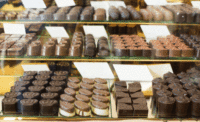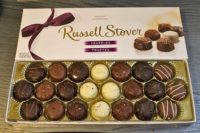
|
“Moderate” growth for the next five years might not sound all that exciting for those in the chocolate confectionery industry, but it’s at least better than the “sluggish” growth they’ve dealt with the last five years.
And it’s exactly what the data research firm Mintel predicts for the sector, in its recently released analysis of the U.S. chocolate market.
The report also reveals that the seasonal chocolate segment is thriving; consumers are demanding healthier options; candy targeted at adults could be the next big thing and that Hershey continues its reign as the U.S.’s No. 1 chocolate company;
What follows is a detailed look at all of those trends :
“Sluggish growth”
Although U.S. chocolate sales technically grew 16% from 2006-11 — reaching $18.6 billion in 2011 — after adjusting for inflation, the sector grew just 6%.
Or, as Mintel describes it, it’s been a “somewhat sluggish growth.”
Growth is still growth though, and increased prices for finished goods, which were caused by higher commodity costs and innovations, were the main factors for that.
The higher prices were a double-edged sword though, as they also motivated consumers to opt for less expensive choices.
As for the next five years, Mintel predicts a moderate 12% growth.
Hershey successful due to innovation
With regards to specific brands, Hershey continues to hold favor with American consumers.
Between 2006-11, the company dominated the market, making up 41% of chocolate confectionery sales in 2011, while Mars accounted for only 28% in FDMx sales.
The report attributes Hershey’s success to its new product innovation. Specifically, the launch of its Reese’s Minis product — which brought about the largest gains in the bag/bar/box (under 3.5-oz) segment — for the Hershey’s Reese’s brand, which grew 23.2% in 2011.
Hershey and Mars also led new product releases during the period, responsible for 6.5% and 5.2% of new releases, respectively.
But, all that brand-name success isn’t the end of the story.
Mintel says 19% of chocolate consumers are actually buying more store brands, and less name brands — likely because of the price differences.
Specifically, young adults aged 18-24 and those from lower-income households, want to know they’re getting the most bang for their buck, prioritizing both premium product attributes and affordability.
Consumer profile:
And based on the data, the 18-24 year-old-market does matter, despite candy’s reputation for being a children’s treat.
In fact, it might not be long before the saying turns into “Like an adult in a candy store.” While candy consumption is on the rise among adults and teens, it’s actually down among kids (aged 6-11).
That means parents — a typical source for candy among children — will be a key marketing group to those who want to buck the trend and increase sales to the industry’s most famous age group.
The good news is, everyone still seems to love eating chocolates, regardless of gender, age and income.
However, what kind of chocolate and what they’re willing to pay for it does vary.
Women are more likely than men to indulge in snack-sized offerings and are more likely than men to associate eating chocolate with positive experiences such as personal reward (celebratory candy bar after the gym, ladies?), whereas men are focused on price.
Meanwhile, higher income earners are most likely to eat boxed chocolates
And, the highest household income earners ($150K+) are the most likely to associate chocolate with a personal reward — an indication that marketing premium, personal products to these consumers could present an opportunity for growth.
Mintel says consumers recognize the nutritional value of premium products, and view them as a “nutritive reward, rather than an empty indulgence.” The report advises marketing premium products as gifting options.
As for the age-old debate between milk and dark chocolate, older consumers and those of higher household incomes tend to prefer dark chocolate, but milk chocolate is still the favorite choice among 57% of consumers, with dark and white chocolate coming in a distant second and third respectively.
Seasonal chocolate sees largest growth
It turns out it also matters exactly what time of year you’re selling your chocolate.
If seasonal chocolate sales continue to be as successful as they are now, you can probably expect gummy squirrels on Squirrel Appreciation Day, and kitten-shaped chocolates on National Hairball Awareness Day (April 29, by the way).
Seasonal chocolate showed the highest sales gains in the chocolate confectionery industry with $4.4 billion, making up 23.7% of category sales.
And, about a quarter of all global chocolate launches in 2011 had a seasonal positioning.
“This year has proved to be a real hot-bed of activity for Easter chocolate,” says Marcia Mogelonsky, director of insight for Mintel Food and Drink. “Seasonal chocolate is, if anything, more recession resistant than the overall market, as the products have broad appeal as gifts for a wide range of recipients, from friends to relatives and co-workers.”
This year’s Easter was particularly strong.
“Easter has consistently led other holidays in innovation — and in sales — as it is a holiday with a strong affinity for confectionery through gift baskets, egg hunts, and other family-focused traditions,” Mogelonsky explains.
The same cannot be said about sugar-free chocolate, which faced the biggest sales declines during this period, down 6.9% from 2009-11 and 27% from 2006-11.
Mintel attributes the decline to a lack of product innovation and to competition — the multitudes of healthy snacking options outside the confectionery category are hindering sugar-free chocolate sales. Moreover, sugar alternatives haven’t quite caught on with mainstream consumers.
Smaller packaging popular, mass merchandisers best retailers
It also looks like consumers are more likely to stop by Target and get a Snickers bar than buy its “king size” equivalent at their local supermarket.
Specifically, smaller format packages (bags, bars and boxes weighing less than 3.5 oz.) saw sales grow 18.5% from 2009-11 — the largest growth of all packaging varieties. And, larger format packages (bags, bars, and boxes weighing more than 3.5 oz.) also performed well during the same time period.
However, as manufacturers respond to consumer demand for smaller pack sizes and less calories, this could change. For example, Mars said earlier this year that by 2013 all its chocolate would have 250 calories or less per serving.
Snack-size, gift box chocolate and novelty chocolate didn’t fare as well in 2011 though, accounting for just 17% of market sales in 2011.
Furthermore, while about three-fourths of consumers buy their chocolate at supermarkets, the retail format faces stiff competition from mass merchandisers, drug stores, convenience stores, speciality stores, vending machines and other locations.
And with mass merchandisers offering both the widest selection and the cheapest prices, it might not be long before supermarkets lose their stronghold.
Look for innovative new products and packaging formats to take advantage of snacking and better-for-you trends and drive continued growth within the chocolate segment. A rebounding economy could also spur sales beyond the “moderate” mode and into a higher gear.









